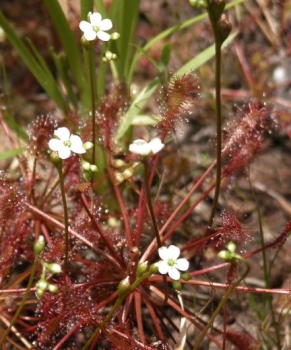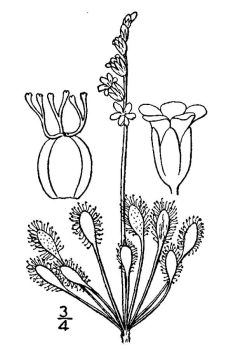Drosera intermedia
 |
 |
Photo courtesy Renee Brecht |
Britton & Brown |
| Botanical name: | Drosera intermedia Haynes |
| Common name: | spatulate leaved sundew |
| Synonomy: | Drosera longifolia Linnaeus Drosera intermedia var. Americana |
| Group: | dicot |
| Family: | Droseraceae |
| Growth type: | forb/herb |
| Duration: | perennial |
| Origin: | native |
| Plant height: | 2 to 8" |
| Foliage: | leaves in a basal rosette; blades 2-3 times as long as wide; covered with reddish, glandular hairs tipped with mucilege. |
| Flower: | white to pale pink, several on one side of a leafless stalk; 5 petals, 4 - 5mm |
| Flowering time: | early July to late August |
| Habitat: | low places in open bogs, sandy shores, often in shallow water; well adapted to nutrient deficienct and acidic soils |
| Range in New Jersey: | throughout much of the state |
| Heritage ranking, if any: | n/a |
| Distribution: |  |
| Misc. | Drosera, from the Greek, droseros (droseros), "dewy, watery"; intermedia, from the Latin, "intermediate"; Sundews trap insects on the sticky, muciligenic hairs then digest them. New Jersey has three species of sundews: spatulate leaved (intermedia), round leaved (rotundifolia) and thread leaved (filiformis). Witmer Stone, in 1910, wrote "This seems to be the most abundant and most generally distributed species of Sundew in South Jersey. There is considerable variation in the size and appearance of the plants. Those of drier situations have a dense rosette-like cluster of small leaves from which the flower scape arises, while those growing in water or wet sphagnum develop a leafy stem often six or seven inches long; the uppermost leaves, from the midst of which the scape springs, being always the largest and freshest" (468). Blooms slightly earlier than Drosera rotundifolia. D. filiformous blooms earliest. Mary Treat of Vineland researched Droseraceae and corresponded with Charles Darwin regarding her research. For more information on this correspondence, visit NJ Pines. |